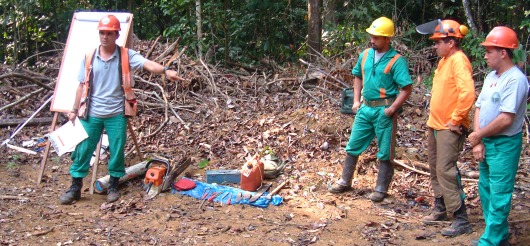Forestry is one of the most dangerous of all occupations; it is sometimes called a “3D” job – dirty, difficult and dangerous. Occupational health and safety in forestry can be greatly improved, however, through adequate worker training and supervision and the use of safety equipment, among other things. This module examines major health and safety issues in forestry – especially in the harvesting, extraction, loading and transport of logs – and effective ways of addressing them. Healthy and safe working conditions are prerequisites for SFM.
Workers may be subject to extreme heat and cold. High temperatures reduce work capacity and may lead to heat stress and dehydration. The risk can be reduced by, for example, the provision of sun shelters, the regular intake of water and the judicious use of rest periods, and by undertaking the heaviest work in the coolest work hours. Cold weather can reduce dexterity, blood flow, muscle strength and balance. Regular food intake, adequate clothing and sufficient facilities for drying clothes can reduce the risk to human health posed by cold weather.
Terrain and site factors, such as slope and soil type, influence work safety. Forestry activities often occur on steep slopes, with a consequent high risk of machinery accidents and rock falls. Finely textured soils (e.g. clays) are slippery when wet, increasing the risk of accidents involving heavy machinery.
Falling trees and branches, chainsaw “kickbacks” and tree hang-ups pose serious risks to workers. Training in safe practices and the use of adequate safety equipment can reduce such risks.
Noise from chainsaws and brushcutters can lead to hearing loss if hearing protection is not used. The use of hand-held power tools such as chainsaws and brushcutters can also cause hand–arm vibration, which can affect blood circulation in the hands and forearms and damage nerves, tendons, muscles, bones and joints. The vibration dampers used in most modern chainsaws can reduce this problem.
Operators of machines such as skidders and loaders may be subject to whole-body vibrations, which can cause lower back pain as well as repetitive strain injuries. Whole-body vibrations can be reduced by the use of vibration-damping seats in machinery and decreased exposure through job rotation.
Loading and unloading wood is a hazardous operation in forestry. Risks can be reduced through the use of safe working routines and adequate personal protective equipment. The transport of wood on narrow roads, possibly in poor weather conditions, is another hazardous activity, the safety of which can be improved through good practices.
The forest sector has a range of chemical hazards, including the potential for exposure to fumes associated with chainsaw use and to pesticides, and biological hazards such as the potential for allergic reactions to plants, pollen and insect bites.
Many rural people collect forest products alone in remote locations and may be exposed to a range of biological hazards as well as to extreme weather, accidents, and – especially for women, children and the elderly – assault.
Forested areas are often considered more unsafe for women than for men. In fact, women and children may be exposed to sexual violence and rape. Such dangers create a barrier for women, who may be forced to shorten the time they spend in forests and, consequently, be limited to more traditionally female jobs. It is not uncommon for women to sell foods and/or provide services like laundry for workers at logging camps; this often involves heavy transport and long trips where they run the risk of being robbed.
Since forest work is usually viewed as a male-dominated field, women are rarely considered when it comes to safety precautions. For instance, tools and equipment tend to be made to fit male workers, creating ergonomic problems for female workers, and making it more difficult for them to find clothes and protective gear to fit them. Additionally, women in the developing world work mostly in the informal sector or in their own households so they don’t have any insurance against risks. Women collecting firewood often have to stay away from home for a long time in remote areas. They have to carry heavy loads for long distances, and they usually have little or no help in the event of an accident. In nurseries, which tend to employ women, workers are often given inadequate protection and are exposed to chemicals.
The risks to pregnant and lactating women in forestry are even more alarming because of the potential for bites from insects or pests. The unhealthy surroundings can be very dangerous both for women and for their children.




